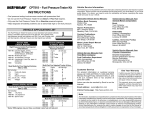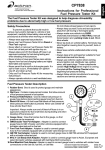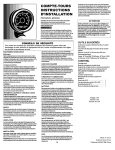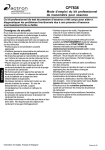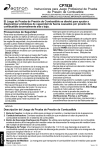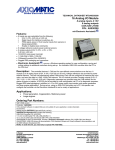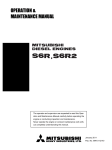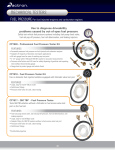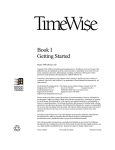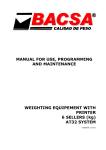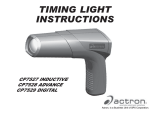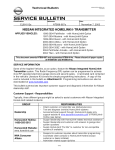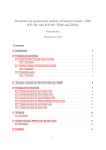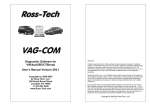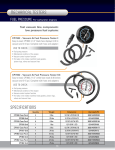Download Actron® Fuel Pressure Tester Kit Installation Instructions
Transcript
® CP7818 – Fuel Pressure Tester Kit INSTRUCTIONS • • • • Fuel pressure testing involves some contact with pressurized fuel. Do not use the Fuel Pressure Tester Kit on Diesel or Flex Fuel engines. Only use the Fuel Pressure Tester Kit on Gasoline powered engines. Helps diagnose driveability problems due to abnormally high or low fuel pressure. VEHICLE APPLICATION LIST The Fuel Pressure Tester Kit works on most domestic fuel injected vehicles having a schrader valve test port on the fuel rail. This includes Ford high pressure central fuel injection and GM, Ford, and Chrysler multiport fuel injection. Multi-port means one fuel injector per cylinder. Domestic FORD, LINCOLN, MERCURY High Pressure Central Fuel Injected (CFI) Vehicles 1981-86 Country Squire, Crown Victoria, LTD, Colony Park, Grand Marquis, & Marquis 1985-86 Mustang & Capri 1985-87 Thunderbird & Cougar 1981-85 Continental, Town Car, Mark VI & Mark VII 1980 Versailles Most Multi-Port Fuel Injected Vehicles 1983 to 1996. Not Including: 1.3L Festiva & Aspire Capri 1.6L 1.8L Escort & Tracer 2.0L, 2.2L & 2.5L Probe 3.0L Villager Domestic GENERAL MOTORS Most Multi-Port Fuel Injected Vehicles 1984 to 1996. Not Including: 1.6L Nova 1988 1988-89 1.5L Spectrum 1987-90 Sprint Turbo Domestic CHRYSLER, PLYMOUTH, DODGE Multi-Port Fuel Injected Passenger Vehicles Year 1995-96 1984-93 1995-96 1984-92 1987-96 1993-96 1987-93 8th VIN Digit Engine 2.0L C or Y 2.2L Turbo E 2.4L X 2.5L Turbo J 3.3L R 3.5L F 3.8L L Multi-Port Fuel Injected Trucks & Vans Year Engine 8th VIN Digit 1996 2.4L B 2.5L Turbo J 1989 1992-96 3.3L R 1994-96 3.8L L 1992-96* 3.9L X 1992-96* 5.2L Y 1993-96 5.9L 5 or Z 1994-96 8.0L W JEEP Multi-Port Fuel Injected Vehicles Year Engine 8th VIN Digit 1991-95 2.5L P 1987-96* 4.0L S 1993-96* 5.2L Y Domestic EAGLE Multi-Port Fuel Injected Vehicles Year Engine 8th VIN Digit 1995-96 2.0L Y 3.3L T 1993-96 1993-96 3.5L F * Some 1996 engines may not have a schrader valve fuel rail test port. Vehicle Service Information: The following is a list of publishers who have manuals containing electronic fuel injection system information. Some manuals may be available at auto parts stores, your local dealer, or your local public library. For others, you need to write for availability and prices, specifying the make, model and year of your vehicle. Aftermarket Vehicle Service Manuals: Chilton Book Company Chilton Way Radnor, PA 19089 Haynes Publications 861 Lawrence Drive Newbury Park, CA 91320 Cordura Publications Mitchell Manuals, Inc. Post Office Box 26260 San Diego, CA 92126 Motor’s Auto Repair Manual Hearst Company 250 W. 55th Street New York, NY 10019 Vehicle Service Manuals from Ford Motor Company: Ford Publication Department Helm Incorporated Post Office Box 07150 Detroit, MI 48207 Vehicle Service Manuals from General Motors Corporation: Buick Tuar Company Post Office Box 354 Flint, MI 48501 Oldsmobile Lansing Lithographers Post Office Box 23188 Lansing, MI 48909 Cadillac, Chevrolet, Pontiac Helm Incorporated Post Office Box 07130 Detroit, MI 48207 Vehicle Service Manuals from Chrysler Corporation: Chrysler Corporation Dyment Distribution Service Service Publication 12200 Alameda Drive Strongsville, Ohio 44136 Note All information, illustrations and specifications contained in this manual are based on the latest information available from industry sources at the time of publication. No warranty (expressed or implied) can be made for its accuracy or completeness, nor is any responsibility assumed by Actron Manufacturing Co. or anyone connected with it for loss or damages suffered through reliance on any information contained in this manual or misuse of accompanying product. Actron Manufacturing Co. reserves the right to make changes at any time to this manual or accompanying product without obligation to notify any person or organization of such changes. Instructions for Fuel Pressure Tester Kit Safety Precautions To prevent accidents that could result in serious injury and/or damage to your vehicle or test equipment, carefully follow these safety rules and test procedures at all times when working on vehicles. • Always wear approved eye protection. • Never use Fuel Pressure Tester Kit on Diesel or Flex Fuel engines! • Never attach Fuel Pressure Tester to any place other than the fuel rail test port. Do not confuse Air Conditioning schrader valves with the fuel rail test port. • Never attach or remove Fuel Pressure Tester Kit from fuel rail test port with the ignition key on. • Always place end of 6 ft. bleed-off hose in an approved container for fuel during testing and when bleeding off fuel pressure. • Never smoke or have open flames near vehicle. Vapors from fuel and charging battery are highly flammable and explosive. • Never permit fuel to spill on hot engine parts. If a spill or leak occurs, immediately turn ignition key off, and clean up fuel. • Only use the Fuel Pressure Tester Kit for measuring fuel pressure on vehicles having schrader valves as their fuel rail test port. Do not use this kit for any other purpose! • Always operate the vehicle in a well ventilated area. Do not inhale exhaust gases or fuel vapors - they are very hazardous! • Always keep yourself, tools and test equipment away from all moving or hot engine parts. • Always make sure the vehicle is in PARK (Automatic transmission) or NEUTRAL (manual transmission) and that the parking brake is firmly set. Block the drive wheels. • Never lay tools on vehicle battery. You may short the terminals together causing harm to yourself, the tools or the battery. • Never leave vehicle unattended while running tests. • Always keep a fire extinguisher suitable for fuel/electrical/chemical fires handy. • Always use extreme caution when working around the ignition coil, distributor cap, ignition wires, and spark plugs. These compo- nents contain High Voltage when the engine is running. • Complete all Pre-Testing Checks before beginning fuel pressure testing. • Always follow vehicle manufacturer’s warnings, cautions and service procedures. CAUTION: Some vehicles are equipped with safety air bags. You must follow vehicle service manual cautions when working around the air bag components or wiring. If the cautions are not followed, the air bag may open up unexpectedly, resulting in personal injury. Note that the air bag can still open up several minutes after the ignition key is off (or even if the vehicle battery is disconnected) because of a special energy reserve module. 1. Dial Face: Measurement scale that shows amount of fuel pressure present in fuel system. 2. Pressure Relief Button: Used to relieve fuel pressure in the gauge hose before disconnecting the gauge hose from the fuel rail. 3. Bleed-Off Hose: A 6-ft. hose that bleeds off fuel pressure when the pressure relief Fig. 1 60 1 300 400 200 20 100 500 80 600 700 kPa psi 100 2 3 4 5 FUEL INJECTORS 5. GM/Chrysler Test Port Adapter: This Ford CFI adapter is used to connect the gauge Throttle Body hose to GM and Chrysler vehicles equipped with a schrader valve test FUEL FUEL RAIL INJECTORS port on the fuel rail. TEST PORT 6. Ford Test Port Adapter: This adapter is used to connect the gauge hose to Ford vehicles equipped with a schrader valve test port on the fuel rail. FUEL PRESSURE REGULATOR PRESSURE LINE RETURN LINE FUEL PRESSURE REGULATOR FUEL RAIL PRESSURE LINE RETURN LINE There are two basic types of fuel injection systems currently being used by GM, Ford, and Chrysler. The first type is called “port” or “multi-port” fuel injection. In this system, GM Multi-Port the fuel injectors spray fuel directly into the Fuel Injection FUEL INJECTORS intake manifold behind the intake Fig. 3 valve. These sysFUEL RAIL FUEL PRESSURE TEST PORT tems typically have REGULATOR FUEL FUEL INJECTORS one fuel injector per RAIL cylinder. The second type is commonly called Throttle Body Injection (TBI) for GM and Chrysler vehicles or Central Fuel Injection (CFI) for Ford vehicles. PRESSURE VACUUM LINE PORT These systems use RETURN one or two fuel injecFUEL INJECTORS LINE tors mounted on top of the intake manifold. They spray fuel FUEL FILTER into the throttle body similarly to a conventional carburetor. See Fig. 2 for illusFUEL TANK trations of both types FUEL PUMP FILTER of fuel systems. FUEL PUMP Fuel System Components 6 Fig. 2 4. Gauge Hose: Hose that carries fuel to the gauge so that pressure can be measured. Fuel Injection System Theory Fuel Pressure Tester Description 40 button is pressed. Never use a bleed-off hose shorter than 6 ft. Important: Always make sure end of bleed-off hose is in an approved container for fuel at all times during testing and when bleeding off fuel pressure!! Before doing any fuel pressure testing, it is a good idea to understand how fuel system components work and how they relate to one another. The fuel pump pumps fuel from the fuel tank to the fuel pressure regulator and fuel injectors. The fuel pressure regulator divides fuel between the pressure line and the return line. The fuel in the pressure line goes to the fuel injectors, while the fuel in the return line is returned to the fuel tank. Fig. 3 shows the orientation of fuel system components in a typical “port” fuel injection system. Fuel Tank: A large container that holds your vehicles supply of fuel. Fig. 4 PROTECTIVE CAP FUEL RAIL TEST PORT Fuel Pump Filter: A filter that is usually located in the fuel tank. Its function is to prevent foreign particles from reaching the fuel pump. A clogged or restricted fuel pump filter can cause low fuel pressure readings. When replacing a fuel pump it is a good idea to clean or replace the fuel pump filter. Fuel Pump: An electric motor that pumps fuel into the fuel system at a constant pressure. It is mounted in the fuel tank or on the frame. Some vehicles have more than one fuel pump. FUEL RAIL Typical GM Multi-Port Fuel Injection System Fig. 5 VACUUM PORT Return Line: Path way for excess fuel to return to the fuel tank. Pressure Line: A pressurized fuel line that carries fuel from the fuel tank to the fuel injectors. Fuel Filter: A filter that is located in-line with the pressure line. Its function is to prevent foreign particles from reaching the fuel injectors. A clogged or restricted fuel filter can also cause low fuel pressure readings. This is the only fuel system component that requires periodic replacement. Refer to vehicle owners manual for replacement interval. Fuel Rail Test Port: A schrader valve located on the fuel rail (Fig. 4) that allows easy connection of a fuel pressure gauge to measure fuel pressure. Do not confuse this valve with the schrader valves that are used for recharging air conditioning systems. Fuel Pressure Regulator: The fuel pressure regulator (Fig. 5) is connected across the pressure line and return line. It contains a spring loaded valve assembly that opens to allow fuel to move into the return line, when the pressure line fuel pressure is exceeded. It is used to keep a constant fuel pressure drop across the fuel injectors. Some fuel pressure regulators have a vacuum port so fuel pressure can be adjusted based on engine load. These are commonly called vacuum actuated (compensated) fuel pressure regulators. A leaking fuel pressure regulator can cause low fuel pressure readings and hard starting problems. Fuel Rail: The fuel rail assembly is bolted to the intake manifold. Its purpose is to hold the fuel injectors in place and to deliver pressurized fuel to the fuel injectors. Fuel Injectors: A precision valve that is controlled by a solenoid. Fuel injection is controlled by the amount of fuel pressure, RETURN LINE PRESSURE LINE Vacuum Actuated (Compensated) Fuel Pressure Regulator and the size and duration of the valve opening. Fuel injectors contain a filter used to prevent very small particles from clogging the valve. Leaking fuel injectors will cause fuel pressure to slowly decrease when the ignition key is on and engine is off. 9. If engine will not start, check ignition system for spark. If no ignition spark is present, refer to vehicle service manual for No Start Diagnostics. Fuel Pressure Testing Procedures Fig. 6 40 100 psi This test procedure explains how to make fuel pressure measurements on vehicles while the ignition key is on and while the engine is at idle. The procedure also explains the safest way to connect and disconnect the fuel pressure tester kit from vehicles equipped with schrader valves as their fuel rail test ports. If the fuel pressure readings measured in this test procedure are not within your vehicles manufacturing specification, then you must use your vehicle service manual along with the fuel pressure tester kit to service the problem. This test procedure does not contain any vehicle specific diagnostics. 1. Read all SAFETY PRECAUTIONS and PRE-TESTING CHECKS. 3. Turn Ignition Key OFF. 2. Do a thorough visual and “hands-on” inspection of the engine and fuel system. Look for loose or cracked electrical wiring, battery cables, ignition wires, and fuel or vacuum lines. 4. Locate fuel rail test port and remove protective cap. (See Fig. 4.) 6. Verify fuel vapor recovery system and gas cap are in good condition. 7. Verify that manifold vacuum is within manufacturers specification which is typically 18-20 in. at idle. 8. Look for fuel leaks and wipe up any spilled fuel immediately. 100 END OF BLEED-OFF HOSE MUST BE PLACED IN AN APPROVED FUEL CONTAINER 1. Read Safety Precautions. 5. Verify that all fuel system fuses are good. 80 600 700 Pre-Testing Checks 4. Verify that the inertia switch on certain Ford/Lincoln/Mercury vehicles has not been tripped. (The inertia switch is usually located in the trunk.) 500 kPa 2. Apply a lightweight household oil to the rubber “O” rings inside both test port adapters. 3. Verify that the battery is fully charged and fuel tank has an adequate supply of fuel. 60 300 400 200 20 For Ford/Lincoln/Mercury Vehicles... • Screw Ford test port adapter to fuel rail test port until finger tight. • Screw GM/Chrysler test port adapter to the Ford test port adapter until finger tight. For GM/Chrysler Vehicles... • Screw GM/Chrysler test port adapter to fuel rail test port until finger tight. Note: Always wrap a shop rag around fuel rail test port when attaching test port adapters. This is a precaution in case a small amount of fuel leaks out while attaching adapters. 5. Place end of 6 ft. bleed-off hose in an approved container for fuel. SHOP RAG FUEL RAIL TEST PORT Bleed-off hose must remain in container until testing is complete. 6. Turn all accessories OFF. (i.e. Radio, A/C, Blower Fan, Headlights, Windshield Wipers...) 7. Turn ignition key ON. Do the following checks... • Listen for fuel pump. Pump should run for approximately 2 seconds. • Check fuel system for leaks. If leaks found, turn ignition key OFF and wipe up fuel immediately! • Read fuel pressure from dial face. Pressure should rise to manufacturers specification and hold steady even after fuel pump stops running. Refer to vehicle service manual for fuel pressure specifications. • If fuel pressure is not within manufacturers specification, than service vehicle according to vehicle service manual. • When repair is completed and key-onengine-off fuel pressure is now within manufacturers specification, then proceed to Step 8. • For instructions on how to safely disconnect the Fuel Pressure Tester Kit from the fuel rail test port, proceed to Step 9. 8. Start engine – Let idle. • If your vehicles fuel system uses a vacuum actuated (compensated) fuel pressure regulator then fuel pressure should drop approximately 3-10 psi, depending on manifold vacuum. • If your vehicles fuel system uses a fuel pressure regulator without a vacuum port than fuel pressure should remain constant during both key-on-engine-off and idle. • Read fuel pressure from dial face. • If fuel pressure is not within manufacturers specification, than service vehicle according to vehicle service manual. • When repair is completed and idle fuel pressure is now within manufacturers specification, then proceed to Step 9. • To safely disconnect the Fuel Pressure Tester Kit from the fuel rail test port and perform repairs at a later time, proceed to Step 9. 9. Turn Ignition Key OFF. 10.Verify that 6 ft. bleed-off hose is still in an approved container for fuel. 11.Fully DEPRESS and HOLD the pressure relief button until dial face pointer is resting on stop pin. 12.Shake bleed-off hose to make sure that all fuel went into approved container. 13.Remove gauge hose from fuel rail test port. For Ford/Lincoln/Mercury Vehicles... • Wrap a shop rag around fuel rail test port in case a small amount of fuel drips out while unscrewing test port adapters. • Unscrew GM/Chrysler test port adapter from Ford test port adapter. • Wrap a shop rag around GM/Chrysler test port adapter so any fuel dripping from gauge hose is absorbed. For GM/Chrysler Vehicles... • Wrap a shop rag around fuel rail test port in case a small amount of fuel drips out while unscrewing test port adapters. • Unscrew GM/Chrysler test port adapter from fuel rail test port. • Wrap a shop rag around GM/Chrysler test port adapter so any fuel dripping from gauge hose is absorbed. • Remove bleed-off hose from approved fuel container and hold gauge hose over container so any remaining fuel will drip into container. 14.Store shop rags in an approved container so they cannot cause personal injury or a hazardous situation. 15.Store Fuel Pressure Tester in a well ventilated area where it cannot cause personal injury or a hazardous situation. General Fuel Pressure Diagnostics Fuel pressure checking is an essential part of fuel injection system troubleshooting. High fuel pressure will make an engine run rich, while low fuel pressure will make an engine run lean or not at all. Care and Maintenance Apply a lightweight household oil to the rubber “O” rings inside both the GM/Chrysler and Ford test port adapters before each use. Fuel pressure readings that are higher than manufacturers specifications are generally caused by a problem in the return line fuel components. Conversely, fuel pressure readings that are lower than manufacturers specifications are generally caused by a problem in the pressure line fuel components. If fuel pressure readings are not within manufacturers specifications, then refer to a vehicle service manual for step-by-step diagnostic procedures that will pinpoint the faulty component for your specific vehicle. Possible causes of high fuel pressure readings are the following: • Faulty fuel pressure regulator. • Restriction in return line. • Faulty fuel line couplings at fuel tank. Possible causes of low fuel pressure readings are the following: • Clogged or restricted fuel filter. • Restriction in pressure line. • Faulty fuel pump. • Faulty fuel pump relay. • Bad fuel pump fuse. • Faulty fuel pump wiring. • Clogged or restricted fuel pump filter. • Faulty fuel pressure regulator. • Leaking fuel injectors. • Faulty fuel line couplings at fuel tank. • Remove bleed-off hose from approved fuel container and hold gauge hose over container so any remaining fuel will drip into container. • Unscrew Ford test port adapter from fuel rail test port. ® ACTRON MANUFACTURING CO. ACTRON HAND TOOLS




